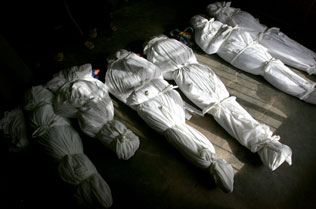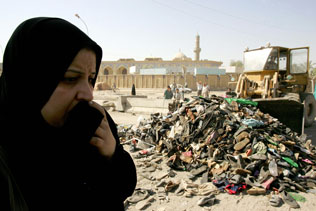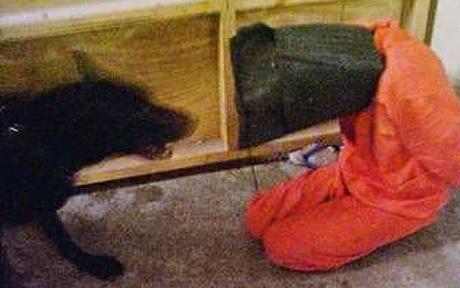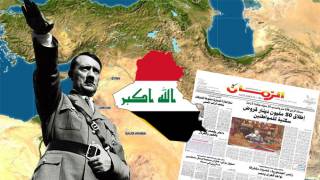WikiLeaks: A Grim Portrait of Civilian Deaths in Iraq
Source: nytimes.com
The reports in the archive disclosed by WikiLeaks offer an incomplete, yet startlingly graphic portrait of one of the most contentious issues in the Iraq war — how many Iraqi civilians have been killed and by whom.The reports make it clear that most civilians, by far, were killed by other Iraqis. Two of the worst days of the war came on Aug. 31, 2005, when a stampede on a bridge in Baghdad killed more than 950 people after several earlier attacks panicked a huge crowd, and on Aug. 14, 2007, when truck bombs killed more than 500 people in a rural area near the border with Syria.
But it was systematic sectarian cleansing that drove the killing to its most frenzied point, making December 2006 the worst month of the war, according to the reports, with about 3,800 civilians killed, roughly equal to the past seven years of murders in New York City. A total of about 1,300 police officers, insurgents and coalition soldiers were also killed in that month.

The shrouded bodies of Iraqi civilians killed during fighting between insurgents and American Marines in Haditha, on Nov. 12, 2005. Lucian Read
The documents also reveal many previously unreported instances in which American soldiers killed civilians — at checkpoints, from helicopters, in operations. Such killings are a central reason Iraqis turned against the American presence in their country, a situation that is now being repeated in Afghanistan.

More than 950 people were killed and hundreds more were injured on Aug. 31, 2005, when rumors of a suicide bomber provoked a stampede in a procession of Shiite pilgrims as they crossed a bridge in northern Baghdad. The belongings of many of the victims were later tossed in a pile.
Karim Sahib/Agence France-Presse — Getty Images
The archive contains reports on at least four cases of lethal shootings from helicopters. In the bloodiest, on July 16, 2007, as many as 26 Iraqis were killed, about half of them civilians. However, the tally was called in by two different people, and it is possible that the deaths were counted twice.
In another case, in February 2007, an Apache helicopter shot and killed two Iraqi men believed to have been firing mortars, even though they made surrendering motions, because, according to a military lawyer cited in the report, “they cannot surrender to aircraft, and are still valid targets.”
The shooting was unusual. In at least three other instances reported in the archive, Iraqis surrendered to helicopter crews without being shot. The Pentagon did not respond to questions from The Times about the rules of engagement for the helicopter strike.
The pace of civilian deaths served as a kind of pulse, whose steady beat told of the success, or failure, of America’s war effort. Americans on both sides of the war debate argued bitterly over facts that grew hazier as the war deepened.
The archive does not put that argument to rest by giving a precise count. As a 2008 report to Congress on the topic makes clear, the figures serve as “guideposts,’ not hard totals. But it does seem to suggest numbers that are roughly in line with those compiled by several sources, including Iraq Body Count, an organization that tracked civilian deaths using press reports, a method the Bush administration repeatedly derided as unreliable and producing inflated numbers. In all, the five-year archive lists more than 100,000 dead from 2004 to 2009, though some deaths are reported more than once, and some reports have inconsistent casualty figures. A 2008 Congressional report warned that record keeping in the war had been so problematic that such statistics should be looked at only as “guideposts.”
In a statement on Friday, Iraq Body Count, which did a preliminary analysis of the archive, estimated that it listed 15,000 deaths that had not been previously disclosed anywhere.
The archive tells thousands of individual stories of loss whose consequences are still being felt in Iraqi families today.
Misunderstandings at checkpoints were often lethal. At one Marine checkpoint, sunlight glinting off a windshield of a car that did not slow down led to the shooting death of a mother and the wounding of three of her daughters and her husband. Hand signals flashed to stop vehicles were often not understood, and soldiers and Marines, who without interpreters were unable to speak to the survivors, were left to wonder why.
According to one particularly painful entry from 2006, an Iraqi wearing a tracksuit was killed by an American sniper who later discovered that the victim was the platoon’s interpreter.
The archive’s data is incomplete. The documents were compiled with an emphasis on speed rather than accuracy; the goal was to spread information as quickly as possible among units. American soldiers did not respond to every incident.
And even when Americans were at the center of the action, as in the western city of Falluja in 2004, none of the Iraqis they killed were categorized as civilians. In the early years of the war, the Pentagon maintained that it did not track Iraqi civilian deaths, but it began releasing rough counts in 2005, after members of Congress demanded a more detailed accounting on the state of the war. In one instance in 2008, the Pentagon used reports similar to the newly released documents to tabulate the war dead.
This month, The Associated Press reported that the Pentagon in July had quietly posted its fullest tally of the death toll of Iraqi civilians and security forces ever, numbers that were first requested in 2005 through the Freedom of Information Act. It was not clear why the total — 76,939 Iraqi civilians and members of the security forces killed between January 2004 and August 2008 — was significantly less than the sum of the archive’s death count.
The archive does not have a category for the main causes of Iraqi deaths inflicted by Americans. Compared with the situation in Afghanistan, in Iraq aerial bombings seemed to be less frequently a cause of civilian deaths, after the initial invasion. The reports were only as good as the soldiers calling them in. One of the most infamous episodes of killings by American soldiers, the shootings of at least 15 Iraqi civilians, including women and children in the western city of Haditha, is misrepresented in the archives. The report stated that the civilians were killed by militants in a bomb attack, the same false version of the episode that was given to the news media.
Civilians have borne the brunt of modern warfare, with 10 civilians dying for every soldier in wars fought since the mid-20th century, compared with 9 soldiers killed for every civilian in World War I, according to a 2001 study by the International Committee of the Red Cross.
Article from: nytimes.com
Beaten, Shocked, Eyes Gouged: Iraq Abuse, WikiLeaked
By Spencer Ackerman | Wired.com

Torture was a signature feature of the state terror that Saddam Hussein inflicted on Iraq. The voluminous Iraq-war documents released by WikiLeaks today show that getting rid of Saddam didn’t eradicate the brutal tendencies of the revamped Iraqi security forces. Detainees were roughed up with pipes, knives, cables, electricity — even a cat in the face. Some suspects were so scared, they confessed to being terrorists, just so they could be shipped to the Americans.
WikiLeaks proved at least one thing through its release of nearly 400,000 U.S. military reports from the Iraq war: the brutalization of detainees continued years after the Abu Ghraib scandal, perpetrated largely by Iraqi police and soldiers whom the U.S. trained. In at least one case, Iraqi police even brawled with private security guards. While early press coverage of the WikiLeaked documents has zeroed in on the abuse, it’s barely scratched the surface.
Searching the WikiLeaks Iraq trove for incidents of reported detainee abuse results in literally thousands of accounts of brutality. Some of them involve U.S. troops allegedly inflicting harm upon detainees in their custody. A detainee held by coalition forces in southern Iraq said in February 2006 that a U.S. task force beat him to the point where he lost one of his eyes. “Capture photo depicts a bandage over his right eye, and injury to his right forearm,” a report reads.
Some of the more gruesome and unseemly accounts of abuse are the result of Iraqi security forces. In Anbar Province in 2005 — then the heart of the Sunni insurgency — Iraqi police threw a cat on a detainee’s face, threatened him with knives and beat him with cables; Iraqi National Guardsmen and even U.S. troops may have been involved. Baghdad cops may have also deprived detainees of medical treatment: one account describes detainees as “walking wounded,” showing visible “open sores”; it notes that some “detainees have died of disease in recent weeks.”
[...]
Read the full article at: wired.comdangerroom
Spiegel: WikiLeaks logs may reveal war crimes
Wikileaks under doubt as “classified” documents substantiate bogus U.S. claims
No coincidence – Assange and Gadahn’s new “leaks”
Atrocity Now: Wikileaks Release Puts Spotlight Back on Continuing War Crime in Iraq
Chemical Weapons, Iranian Agents and Massive Death Tolls Exposed in WikiLeaks’ Iraq Docs
Wikileaks: Americans handed over captives to Iraq torture squads






















